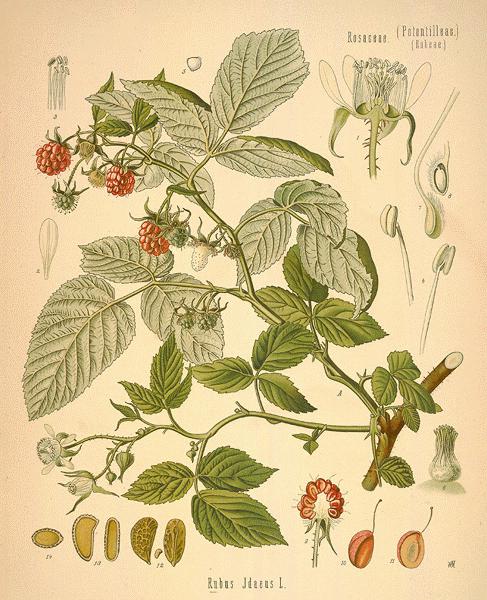Dr Clare Materia Medica
Introduction to the Dispensing of Dr Clare’s Blended Herbs
Special | A | B | C | D | E | F | G | H | I | J | K | L | M | N | O | P | Q | R | S | T | U | V | W | X | Y | Z | ALL
R |
|---|
Raspberry leaf (Red Raspberry)
Framboise, Framboise Rouge, Framboisier Rouge, Framboisier Sauvage, Frambuesa Roja, Raspberry, Rubi Idaei Folium, Rubus. Scientific Name: Rubus idaeus, synonym Rubus buschii, Rubus strigosus. People Use This For: Orally, red raspberry leaf is used for GI tract disorders, upper and lower respiratory tract disorders, cardiovascular system disorders, influenza, swine flu, fever, diabetes, vitamin deficiency, as a diaphoretic or diuretic, for stimulating bile production, "purification of skin and blood", diarrhea, dysmenorrhea, menorrhagia, morning sickness associated with pregnancy, preventing miscarriage, and facilitating labor and delivery. Topically, red raspberry leaf is used for inflammation of the mouth and throat, and skin rash and inflammation. Safety: LIKELY SAFE ...when used orally in amounts commonly found in foods (9). Effectiveness: Labor facilitation. Taking red raspberry leaf orally does not seem to reduce the length of labor or decrease the need for analgesics in the perinatal time period (5). There is insufficient reliable information available about the effectiveness of red raspberry leaf for its other uses. Machanism of Action: The applicable parts of red raspberry are the fruit (berry) and leaf. Red raspberry contains anthocyanidins, ellagitannins, flavonols such as quercetin and kaempferol, catechins, and phenolic acids. Other constituents include ascorbic acid, beta-carotene, chlorogenic acid, glutathione, and alpha-tocopherol (7,8 ,6). The contents of the fruit and leaves vary with maturity (8). Adverse Reactions: None reported. Interactions with Foods: None known. Interactions with Lab Tests: None known. Interactions with Diseases or Conditions: HORMONE SENSITIVE CANCERS/CONDITIONS: Red raspberry leaf might have estrogenic effects (3). Women with hormone sensitive conditions should avoid red raspberry leaf including breast, uterine, and ovarian cancer, endometriosis, and uterine fibroids. Dosage/Administration: ORAL: For facilitating labor, midwives typically prescribe red raspberry leaf tea prepared by steeping 2 grams dried leaf in 240 mL of boiling water for 5 minutes and then straining (2). Red raspberry leaf tablets 2.4 grams per day have been used for reducing labor pains, starting at 32 weeks gestation through labor (5). Editor's Comments: Red raspberry leaf extract has been used in Europe for centuries. The therapeutic use of red raspberry leaf was first described in 1597 in The Herbal, or a General History of Plants (1). Specific References: Raspberry
1. Eagon PK, Elm MS, Hunter DS, et al. Medicinal herbs: modulation of estrogen action. Era of Hope Mtg, Dept Defense; Breast Cancer Res Prog, Atlanta, GA 2000;Jun 8-11. 2. Parsons M, Simpson M, Ponton T. Raspberry leaf and its effects on labour: safety and efficacy. Aust Coll Midwives Inc J 1999;12:20-5. 3. Simpson M, Parsons M, Greenwood J, Wade K. Raspberry leaf in pregnancy: its safety and efficacy in labor. J Midwifery Womens Health 2001;46:51-9. 4. Wada L, Ou B. Antioxidant activity and phenolic content of Oregon caneberries. J Agric Food Chem 2002;50:3495-500. 5. Wang SY, Jiao H. Scavenging capacity of berry crops on superoxide radicals, hydrogen peroxide, hydroxyl radicals, and singlet oxygen. J Agric Food Chem 2000;48:5677-84. 6. Wang SY, Lin HS. Antioxidant activity in fruits and leaves of blackberry, raspberry, and strawberry varies with cultivar and developmental stage. J Agric Food Chem 2000;48:140-6. 7. Mullen W, McGinn J, Lean ME, et al. Ellagitannins, flavonoids, and other phenolics in red raspberries and their contribution to antioxidant capacity and vasorelaxation properties. J Agric Food Chem 2002;50:5191-6. 8. Morimoto C, Satoh Y, Hara M, et al. Anti-obese action of raspberry ketone. Life Sci 2005;77:194-204. | |

 Also Known As:
Also Known As: